
Understanding the Wall Angle Cold Roll Forming Machine in Drywall Construction
In the rapidly evolving world of construction, efficiency and precision are paramount. One important element in the drywall system is the wall angle, which plays a crucial role in ensuring the structural integrity and aesthetic appeal of any interior space. To manufacture these wall angles with the utmost efficiency and accuracy, the wall angle cold roll forming machine has become an invaluable asset.
What is a Wall Angle?
A wall angle is a critical component in drywall installation. It is typically used to create a corner where drywall sheets meet, providing a clean and stable edge that can be finished with joint compound or tape. Without proper wall angles, drywall installations can appear uneven and unprofessional. Moreover, wall angles help support the drywall and ensure that it is securely attached to the framework of walls and ceilings.
Cold Roll Forming Process
Cold roll forming is a manufacturing process that involves the bending and shaping of metal strips into uniform profiles, such as wall angles. The process is called cold because it occurs at room temperature, which helps preserve the metal's properties and leads to superior strength and durability in the final product. Cold roll forming machines are highly efficient, allowing manufacturers to produce long lengths of wall angle with minimal waste and time.
The wall angle cold roll forming machine operates by feeding a flat metal strip, typically made of galvanized steel or aluminum, through a series of rollers. As the strip passes through these rollers, it is gradually shaped into the desired cross-sectional profile. This method is particularly favored for wall angles due to its ability to produce consistent, high-quality products in large quantities.
Benefits of Using a Wall Angle Cold Roll Forming Machine
1. High Precision and Consistency One of the most significant advantages of using a cold roll forming machine is the precision it offers. Each piece of wall angle produced is identical, which is essential for large construction projects where uniformity is key.

2. Reduced Waste The cold roll forming process generates less scrap material compared to Traditional methods. This not only leads to cost savings but also aligns with modern sustainability practices in the construction industry.
3. Improved Strength Cold-formed metals tend to have enhanced strength characteristics, which enhances the overall stability and durability of the wall angles. This is particularly important in high-load applications.
4. Customization Options The cold roll forming machine can be adjusted to create various profiles and sizes of wall angles, catering to diverse construction needs. Whether it's for residential or commercial projects, flexibility is a significant advantage.
5. Rapid Production Rates These machines are designed for high-speed production, allowing manufacturers to meet the demands of large-scale construction projects without compromising quality.
6. Simplified Installation Process With uniformly produced wall angles, the installation process becomes smoother and quicker. Installers can work more efficiently, reducing downtime on the job site.
Applications in the Construction Industry
The wall angle cold roll forming machine has a wide range of applications in the construction industry, particularly in drywall and metal stud framing. It's commonly used in residential homes, commercial buildings, and even in specialized projects like theaters and auditoriums, where precise angles and corners are necessary for both aesthetics and acoustics.
Conclusion
In conclusion, the wall angle cold roll forming machine represents a blend of innovation and practicality in modern construction methodologies. Its ability to produce high-quality, consistent wall angles efficiently makes it a cornerstone of drywall installation. As the construction industry continues to evolve, machines like the wall angle cold roll forming machine will likely play an increasingly vital role in ensuring projects are completed on time, within budget, and to the highest standards of quality. By investing in advanced machinery, manufacturers and contractors can enhance their productivity and maintain a competitive edge in a dynamic marketplace.